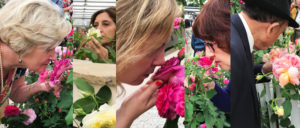By Todd Haiman
Garden design is highly sensitive to change throughout the seasons, the elements, and the existing site. As a garden designer working within the urban landscape of New York City my intention is to create moments and vignettes to stimulate the senses, to transport the garden sojourner.
We explore the sensory experience of gardens specifically as places where people encounter landscape in a staged manner, as a result of intentional design.
-D. Fairchild Ruggles
The experience one encounters within the garden are ever-changing and evanescent. Sound and scent are spatial and temporal. They depend upon the space we inhabit, the extent of that space, and how long the experience lasts. Sound and scent are non-visual and subjective to the person in the setting. Two people in the same situation will likely have a uniquely different commentary on the same landscape experience.
A small residential garden or walled urban garden restrains the sensual garden experience because of its limited size, yet concurrently it intensifies one’s experience by its enclosure (fence heights), cutting out the visuals of the outside world, trapping the sounds and scents within. Elizabeth Fowler in Acoustic Delay: Body Technique and the Hortus Conclusus writes “The sensory experience a garden offers is yet more evanescent than the garden itself. She goes on to say “Enclosure is a (garden design) method of altering and filtering the stream of sensory information we encounter…it cuts out the sensory horizons with the frame of its wall and so delays the advent of the outside world.”
The Perfumed Garden
In the Trianon gardens and the Orangeries at Versailles “a concentration of fragrant flowers were placed in smaller and more enclosed spaces, where the impact of their fragrance would be all the greater. (Tuberoses, jasmines, hyacinths, orange blossoms, roses, carnations, and pinks.) This evidence is crucial to our understanding of how both fragrance and flowers could be used to greatest effect in the garden,” According to Elizabeth Hyde in Cultivated Power: Flowers, Culture, and Politics in the Reign of Louis XIV.
Scent. Safe to say that virtually all perfumes created in a laboratory have had their original formulary in nature. Here are a few plants to consider in your garden design beyond the obvious choices of roses, lilacs, lavender, and wisteria.
- Witch Hazel (Hamamelis spp.)
- Carolina allspice (Calycanthus floridus)
- Spicebush (Lindera benzoin)
- Sweet coneflower (Rudbeckia subtomentosa)
- Sage (Salvia spp.)
- Garden Thyme (Thymus vulgaris)
- Hyssop (Agastache spp)
- Lavender Cotton (Santolina spp.)
- Wild Sweet William (Phlox spp.)

Stop and smell the roses.
Scented Plants in the Garden | A Garden Formulary
Can you keep a pot of overgrown lavender or lemon balm near a door or along a path at arm’s reach, such that passersby brush up against it and release its fragrant oils? Other great scented plants are scented geranium (Pelargonium), mints (Mentha), basils (Ocimum basilicum), and Oregano (Ooriganum}. Walk through a path overplanted with sweet fern(Comptonia peregrina), chamomile, or hay-scented fern(Dennstaedtia punctilobula.) Plant tough mat-forming herbs such as chamomile or mint between footpath pavers – misstepping or allowing summer’s heat to release the scented oils of this ground cover.
Consider the direction in which the wind typically moves within your garden, which will inform you on where best to place scented shrubs. Downwind from a blooming sweet pepperbush (Clethra alnifolia) is a great place to lounge —place these olfactory wonders appropriate to a sitting or gathering area.
Evening gardens. As a moonlit garden was an essential part of all 17th-century Rajput palaces, it is equally necessary for the summer evening spent in a Brooklyn brownstone garden or a Tribeca roof garden.
Many of the fragrant plants associated with the moonlight gardens have white flowers. Here are a few to choose from…
- Yellow angel’s Trumpet (Brugmansia x candida)
- Citron daylily (Hemerocallis citrina)
- Moonflower (Ipomoea alba)
- Flowering tobacco (Nicotiana x sanderae, N. alata)
- Evening primrose (Oenothera pallida)
A common practice of garden designers is orchestrating their perennials/woodies to bloom at different times of the year to create seasonal interest. In harmony with that approach, a garden could be designed to feature plants that release their scent at different times of the year.
Designing with nature, working with the seasons, capturing the essence of the season begins with Koreanspice viburnum(Viburnum carlesii) and pinxterbloom azalea (Rhododendron periclymenoides) in spring, Virginia sweetspire (Itea virginica) in early summer, sweet pepper bush (Clethra alnifolia) in summer, and so on through fall with sweet goldenrod (Solidago odora) and black cohosh (Actaea racemosa.)
More so than other arts, garden design and landscape design can summon all our sensual responses. Gardens, plantings, landscapes can be designed to stimulate all the senses, not just what we see with our eyes.
About the Author
Todd Haiman received his graduate degree with a Master of Science in Landscape Design from Columbia University. Additionally studying at the New York Botanical Gardens within the School of Professional Horticulture and Landscape Design. Mr. Haiman is a member of APLD (Association of Professional Landscape Designers), Royal Horticultural Society, and Metro-Hort. Todd was born in Brooklyn and presently resides in NYC.
In past years, his work was featured in the 6th annual European Biennial of Landscape Architecture in Barcelona, Spain. His “Reading Rooms” design was included in an international exhibition on Vertical Gardens, subsequently featured at AIA San Francisco. Todd Haiman Landscape Design

